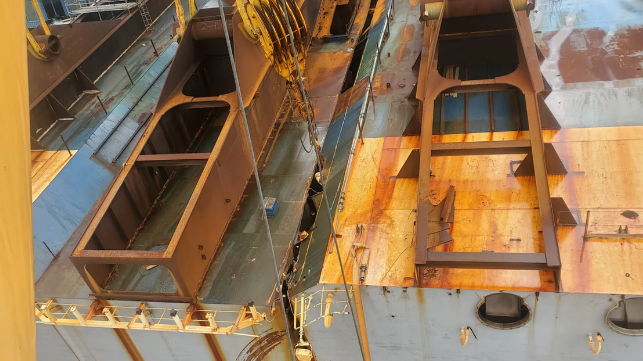Salvors Make Progress on Fifth Cut of Golden Ray Wreck Removal

Undeterred by the fire that burnt through the interior of the wrecked ro/ro Golden Ray last month, salvors are making progress on a fifth cut through the defunct vessel's hull. However, fuel oil spillage from the wreck remains a concern, according to the Georgia Department of Public Health.
Photos provided by the incident command show that the cutting chain is tearing its way up the bottom of the hull as expected and has reached the turn of the bilge. As during previous stages, the operations team paused during the cut for an inspection and overhaul process, replacing the wires in the rigging blocks used for cutting.
The wreck removal process for Golden Ray has always involved a risk of oil pollution, and the fifth cut has been no exception. On Tuesday, oil globules and surface sheening escaped the containment boom structure that surrounds the wreck and spread across nearby waters of St. Simons Sound.
“When the current picks up, it is swift enough to pull the oil underneath the boom,” U.S. Coast Guard spokesman Michael Himes told The Brunswick News.
In response to the release, the Georgia Department of Public Health's Coastal Health District issued a warning to the public, cautioning swimmers and fishermen to watch out for oil near Jekyll Island and St. Simons Island.
"As the cutting operations continue on the capsized motor vehicle carrier Golden Ray, occasional discharges of oil are occurring. Some of the oil is reaching the coastline in the form of small, sticky globules and may be encountered by individuals who are swimming or fishing," warned the department's Coastal Health District. "Do not swim or fish in an area with a visible oil sheen."

Dark swirl of fuel oil emerges from the wreck of the Golden Ray, June 1 (St. Simons Sound Incident Response)

Skimmer boats attempt to mitigate the sheet outside of the environmental protection barrier, June 1 (St. Simons Sound Incident Response)

Responders spread sphagnum moss over an area of oiled marsh, June 5 (St. Simons Sound Incident Response)
The response command's shoreline teams found and collected fresh globules of bunker fuel from both Jekyll and St. Simons Islands after the discharge. Their responders also found several patches of oiled marshland and spread sphagnum moss as an abatement measure. (Sphagnum moss is a natural spill control treatment that binds to oil, helps it break down and reduces the chance that it will come in contact with wildlife.)
The Golden Ray went aground and partially capsized in Georgia's St. Simons Sound in September 2019. During an outbound transit in calm conditions, a routine turn to starboard turned into an uncontrolled runaway maneuver, ending with the vessel aground and resting on her side. Lt. Ian Oviatt, a staff engineer at the Coast Guard Marine Safety Center, told the NTSB that the vessel had taken on too little ballast for her cargo load. “The cause of the vessel capsizing was lack of righting energy due to the way the vessel was loaded,” Oviatt testified before an NTSB panel last September. “The vessel could have taken on additional ballast to be in compliance.”
